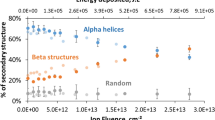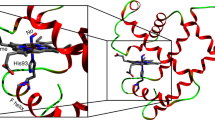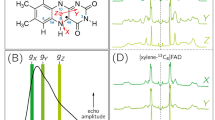Abstract
ALTHOUGH the technique of electron spin resonance (ESR) has been useful in the identification of some of the secondary radical species formed in γ-irradiated DNA and proteins, difficulties have been experienced in the interpretation of the spectra of the primary radiolytic products. Two of these secondary species are the thymine radical (with an additional H-atom on C-6 of the thymine ring) in DNA (refs. 1–3) and the radical R—CH2—S in cystine-containing proteins4–6. Both have been postulated to be the result of electron reactions7–10. We have irradiated two model compounds, thymidine and cystamine, in frozen glasses of either ethanediol–water (1:1) or 6 M NaOH and, by comparing the ESR and optical absorption spectra, we have identified the anions produced.
This is a preview of subscription content, access via your institution
Access options
Subscribe to this journal
Receive 51 print issues and online access
$199.00 per year
only $3.90 per issue
Buy this article
- Purchase on Springer Link
- Instant access to full article PDF
Prices may be subject to local taxes which are calculated during checkout
Similar content being viewed by others
References
Ehrenberg, A., Ehrenberg, L., and Löfroth, G., Nature, 200, 376 (1963).
Salovey, R., Shulman, R. G., and Walsh, jun., W. M., J. Chem. Phys., 39, 839 (1963).
Pruden, B., Snipes, W., and Gordy, W., Proc. US Nat. Acad. Sci., 53, 917 (1965).
Gordy, W., and Shields, H., Proc. US Nat. Acad. Sci., 46, 1124 (1960).
Kurita, Y., and Gordy, W., J. Chem. Phys., 34, 282 (1961).
Henriksen, T., Sanner, T., and Pihl, A., Rad. Res., 18, 147 (1963).
Ormerod, M. G., Int. J. Rad. Biol., 9, 291 (1965).
Lenherr, A. D., and Ormerod, M. G., Biochim. Biophys. Acta, 166, 298 (1968).
Holroyd, R. A., and Glass, J. W., Int. J. Rad. Biol., 14, 445 (1969).
Ormerod, M. G., and Singh, B. B., Biochim. Biophys. Acta, 120, 413 (1966).
Simons, J. P., J. Sci. Instrum. Ser. 2, 1, 872 (1968).
Schulte-Frohlinde, D., and Eiben, K., Z. Naturforsch., 17a, 445 (1962); 18a, 199 (1963).
Moorthy, P. N., and Weiss, J. J., Adv. Chem. Ser., 50, 180 (1965).
Henriksen, T., J. Chem. Phys., 37, 2189 (1962).
Adams, G. E., Armstrong, R. C., Charlesby, A., Michael, B. D., and Willson, R. L., Trans. Faraday Soc., 65, 732 (1969).
Ayscough, P. B., Collins, R. G., and Dainton, F. S., Nature, 205, 965 (1965).
Myers, jun., L. S., Hollis, M. L., and Theard, L. M., Adv. Chem. Ser., 81, 345 (1968).
Singh, B. B., and Ormerod, M. G., Nature, 206, 1314 (1965).
Singh, B. B., and Ormerod, M. G., Int. J. Rad. Biol., 10, 369 (1966).
Singh, B. B., and Ormerod, M. G., Biochim. Biophys. Res. Commun., 25, 28 (1966).
Author information
Authors and Affiliations
Rights and permissions
About this article
Cite this article
LENHERR, A., ORMEROD, M. Electron Reactions in γ-Irradiated Thymidine and Cystamine. Nature 225, 546–547 (1970). https://doi.org/10.1038/225546a0
Received:
Revised:
Issue Date:
DOI: https://doi.org/10.1038/225546a0
Comments
By submitting a comment you agree to abide by our Terms and Community Guidelines. If you find something abusive or that does not comply with our terms or guidelines please flag it as inappropriate.



